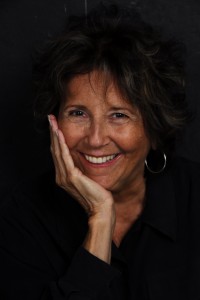 Click on Roberta’s image to go to her website.
Click on Roberta’s image to go to her website.
Roberta is one of Key West’s treasures. She has been here for the better part of 30 years and spends summers isolated somewhere in rural Europe creating her own paint and collage work and bringing her best thoughts and discoveries back to her students. Being in one of her classes is an experience that most want to repeat if the sight of familiar faces is any indication. In a class of type A personalities, silence save the sound of Roberta speaking is the rule of thumb. She is the Spalding Gray of the artworld. Her stories undulate, move back and forth between images and nobody in this room of first rate talkers disturbs the fictional dream Roberta spins at the front of the class.
I took my first Roberta Marks Abstract Art class at The Studios Key West (TSKW) before I even realized I liked Abstract Art. I didn’t dislike it, I just didn’t trust or understand the principles behind it. Martha Barnes, program director of TSKW talked me into it by appealing to my desire not to be left out.
“It’s almost full, she said while I was a passenger in a car driving north. You’ll have to make up your mind right now because I can’t guarantee that there will be any room in a week.” So being a pushover, I gave up my credit card information, signed in and almost instantly regretted it. I mean I do paint and here is the type of work I typically produce.
There is nothing abstract about a bunny rabbit or baby gorilla in a field no matter how you spin it! But I had claimed to want out of old patterns, comfort zones, and craved adventure, expansion. We don’t come to Key West by chance, you have to be just a little off to love it here so I thought, what the hell, it’s only a class and if I don’t like it, I don’t have to show up. Halfway through the first class, I realized that this was not about technique. Desperate for information, all I could get out of Roberta is that we had to use large canvases, acrylic paint and brushes no less that 1 inch wide; the bigger the better. Oh yes, she also suggested that we use short handled brushes to better connect with the canvas.
“Just take a deep breath and make a mark on the canvas – not a delicate teensy mark, a big bold swath of paint and let it come to you. Don’t overthink or overanalyze it.”
By the time the second class rolled around, myself, and another newbie were terrified at showing our work and having it critiqued. Here are the easels where we bring our work to be peer critiqued. The room is large and the walk to the easel is long. . .
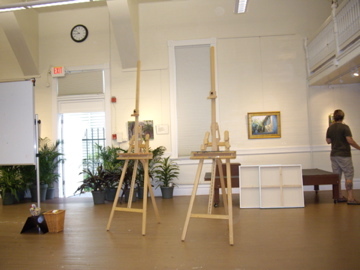 The quality of the work produced in these classes is breathtakingly beautiful. Many students are accomplished artists who are represented by galleries and have had solo and group exhibitions.
The quality of the work produced in these classes is breathtakingly beautiful. Many students are accomplished artists who are represented by galleries and have had solo and group exhibitions.
Michele has been in Roberta’s class before and her work has a mysterious and ethereal quality. Here is a recent example.
 Lucy Paige as another artist that inspires me. She is also a long time student of Roberta Marks.
Lucy Paige as another artist that inspires me. She is also a long time student of Roberta Marks.
I was hooked. it had been so long since I was terrified of someone’s opinion and longer still since I had been willing to make a fool of myself by attempting something truly foreign. I have always enjoyed a bit of trepidation, strange terrain, so I was keen. Actually, I was giddy with excitement at the prospect of learning something truly new and mysterious.
Woven through the fabric of these classes are observations gleaned from her practice as a Buddhist. Imbued in the practice is the gift of attention to all things great and small. I have to say that not everyone is (always) thrilled at receiving that gift.
Last class Roberta informed us that although she has experienced many tears in class, so far no one has actually passed out. She says things like this all the time without a trace of attitude, she is very matter-of-fact about her own perceptions, detached, observant. When Roberta stands before one of our paintings, the intensity of her focus is palpable. I can actually feel the energy directed at the work. Like many things genuine, it it paradoxical, both filling and depleting her at the same time. By end of class she often seems exhausted.
A few summers ago I was in Italy and a family member expressed a violent refusal to go to the modern art wing of the Vatican Museum. I was dying to go as was another family member. After so much perfection and so many rich landscapes and religious images, I longed for something interior. My resistant family member argued that “a 5 year old could do just as well, a dog could run over paint and if you called it a Pollock no one would know.” People are terrified of being ‘fooled’ by a trickster when they approach a painting with their emotional compass the only point of reference. It was unnerving watching people trying to access the work.
Last year, TSKW put on an exhibition of Roberta’s students work and I had great fun standing outside, listening to commentary as people left, no longer burdened by having to be polite for fear that the artist was within earshot.
Here is the poster used to announce the exhibition.
I have learned that representational art is created from the outside in. In representational art a woman looks like a woman a bunny rabbit like a bunny rabbit, etc. This work is easily accessible to all who view it because the outside, or form of the work is depicted.
This is not to say that representational art does not get to the soul of the subject– it is not a judgment on the form but rather that representational art chooses the exterior as the pathway to the meaning of the thing while abstract art jumps into the interior.
Abstract art is created from the inside out. Abstract art is self-referencing and attempts to depict an emotion or idea without relying on conventional imagery which is probably why most people have such difficulty with the form. The point of relativity is obscure and not immediately obvious so many people will be angry at having to search for the meaning of a particular piece. It is hard to stand before a piece and access what it makes you feel in a world that numbs you out to your own opinions, resonances. Abstract art forces us to stop look and feel, not think, although thoughts often tumble out when confronted with an energetic piece of work. From what I have seen and heard outside exhibitions while eavesdropping on people talking, this makes many people angry.
The fabulous Ted Stazesk
But, if a piece is self referencing, how can it be judged? I do not profess to have the answer to that because precisely what makes this work so compelling is that it defies definition relying on intuitive senses of pattern color, juxtapositions. The really weird thing about these classes with Roberta is that the brain really does know what works, what is accomplished and what needs work – what irritates (not always a bad thing) and what simply lies flat and evokes nothing. There is often consensus on line, color, form and why and where a piece succeeds or fails.
Another recent piece by Michele
Nancy Gore’s unusual color sense.
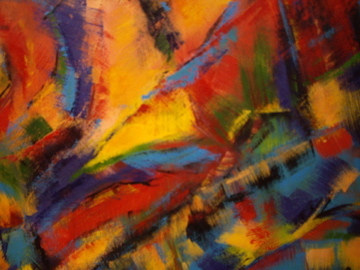 Last year Roberta launched into a story of a painting she was creating in an defunct boulangerie in Biel, Switzerland. She was struggling with the work and didn’t know how to end it, how to finish the piece. Occasionally a young boy would peer in while she was working. He was deaf and seemed to be interested in what she was up to and then one day the presence of the boy took on great symbolic meaning and she dipped her brush into red paint and put a mark on the canvas. She turned to the class remembering the incident. Her face lit up and she said,
Last year Roberta launched into a story of a painting she was creating in an defunct boulangerie in Biel, Switzerland. She was struggling with the work and didn’t know how to end it, how to finish the piece. Occasionally a young boy would peer in while she was working. He was deaf and seemed to be interested in what she was up to and then one day the presence of the boy took on great symbolic meaning and she dipped her brush into red paint and put a mark on the canvas. She turned to the class remembering the incident. Her face lit up and she said,
“That was it. It was finished,” and somehow I could see the canvas and feel the moment and I believed her.
I believed every word she said.
Roberta’s next exhibition will be held at the Lucky Street Gallery on February 25, 2011.

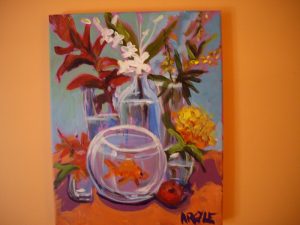
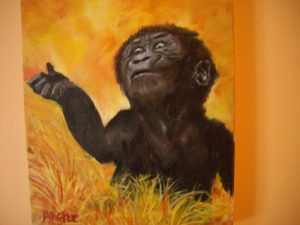

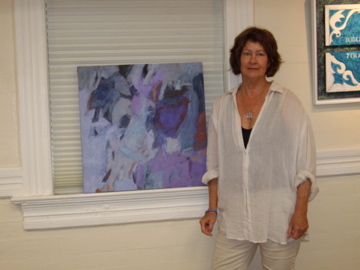
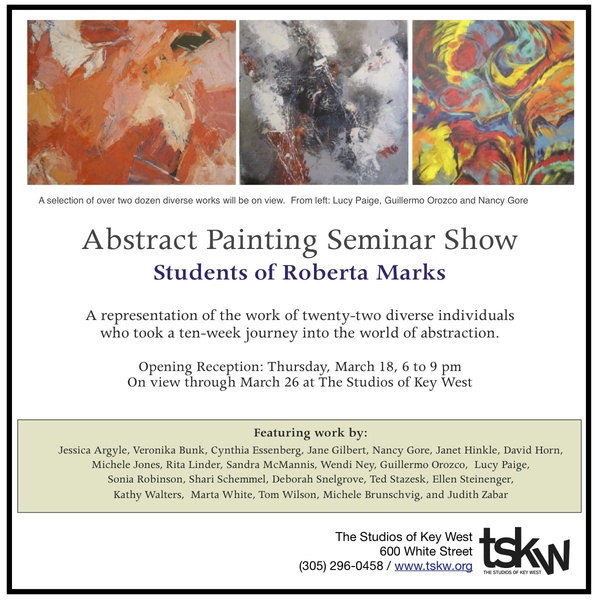
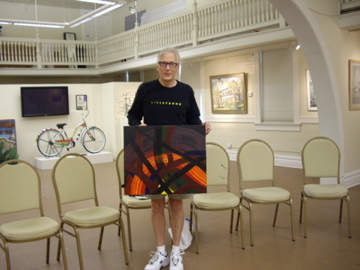
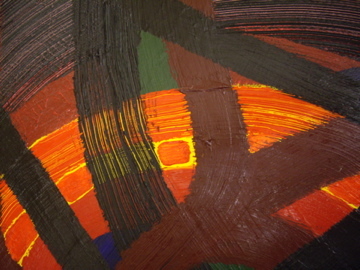


A wonderful, thoughtful piece that captures the magic of Roberta’s class. Thank you for writing it.
Kathy
Jessica, what a nice piece on Robertas class. I am one of the new students and can relate to what you said about the long walk up to the eisle to be critiqued. It is a stretch for me as well. Thanks for writing it. The photos are great too. It’s a nice description of the journey we are on. ~Karen
I am a big fan of Lucy Paige’s artwork. I didn’t know she was a student of Roberta’s. Great to hear about the art scene in Key West!
My dear friend Roberta,
What a wonderful combination—your thoughts as absorbed by one of your students and restated from that student’s viewpoint. Perfect! Just like so much of your work and…you yourself! Hang in there — no matter from how many miles away, I’m with you all the way. You’re an inspiration to me, even if I myself couldn’t “abstract” a single emotion onto canvas (and only barely into prose).
Love,
Margie
I really enjoyed your post and the images on the class in Key West. I feel compelled to add my thoughts on the definition of abstract painting. In my experience abstract painting is rooted in interpretation of actual objects and nature. For example, Hans Hofmann’s “Search for the Real” focuses on the abstraction of the natural world, such as a still life, into planes of color. The process in the class sounds more like abstract expressionism, but even there images of women or other actual objects sometimes figure into the artist’s process and/or even into the painting itself.
Kandinsky’s abstract work relating theosophical notions and other more internal feelings and spiritual energies to painting are more self-referential but his style is much less gestural than the work from the class.
Yes, I am going on and on but the whole of abstract art is very close to my heart because of its complexity and the varied starting points for individual artists. No criticism of the class intended here, merely a discussion point on how ‘abstract’ abstraction really can be.
Thank you so much for your considered thoughts on the subject of abstract art. It is obvious that you love and are very informed on the subject. This class is about opening the heart to various ways of seeing without allowing too much theory to get in the way of the actual doing. Last year (my first), I disallowed myself the luxury of reading books on the subject. I generally am an information hound, sniffing out material to provide me with direction – mostly to reassure myself that I am on the right track, which I then emulate (unconsciously, or rather semi-consciously). While I understand that it is impossible to escape categorization, I think that is precisely what Hans Hoffmann and Kandinsky did, otherwise they would not have movements or styles named after them. And while I know that for every Kandinsky there are a gazillion Jessicas and Freds and Aarons, so be it. I happily imagine that they approve and applaud the efforts of our little classroom. But you are correct. Roberta has always stated that this class is mainly (but not solely) based in abstract expressionism. What I had hoped to convey is that Roberta’s great respect for her student’s work allows for a very personal unfolding – much the way great editors don’t mess with a writer’s ‘voice’. Thank you again for more insight into this fascinating subject.